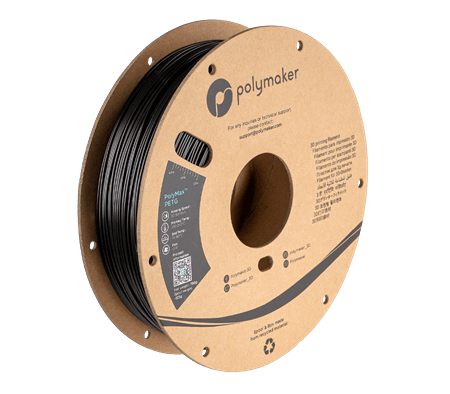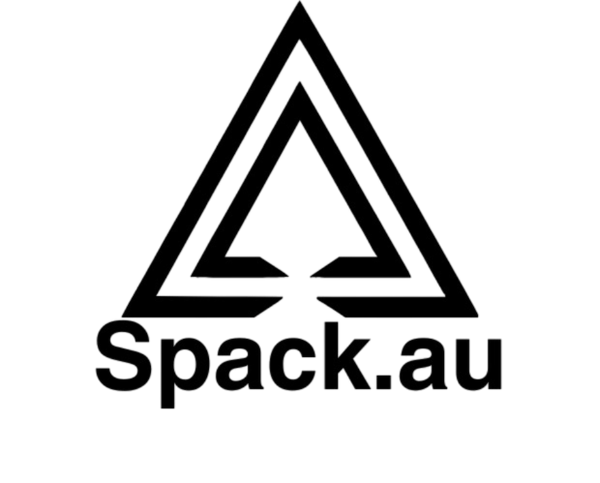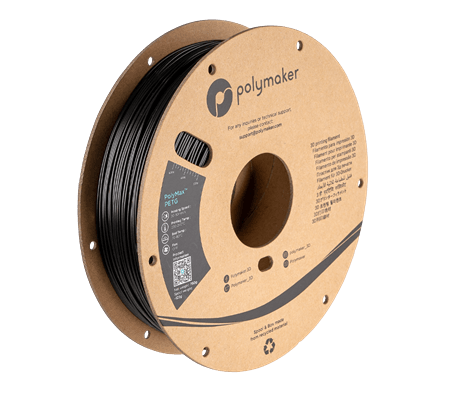Polymaker
Polymaker PolyMax PETG 750g 1.75mm Filament
Polymaker PolyMax PETG 750g 1.75mm Filament
Low stock: 1 left
Couldn't load pickup availability
Toughness enhanced, PolyMax™ PETG is nano-reinforced to combine the stiffness and strength associated with PETG with similar impact strength to PCTG.
- High quality Polymaker Tough PETG.
- Formulated to offer improved impact strength compared to PolyLite™ PLA and PETG.
- Great fracture toughness and ductility with improved stiffness compared to PolyLite™ PETG.
- Good heat resistance up to 80℃.
- Improved sanding capability compared to regular PLA.
- Consistent colour and tolerance (1.75mm diameter +/- 0.03mm)

PolyMax™ is a family of advanced 3D printing filaments produced with Polymaker’s Nano-reinforcement technology, to deliver exceptional mechanical properties and printing quality. PolyMax™ PETG is an impact-modified PETG offering better mechanical properties than any other regular PETG and making it a good candidate for a wide range of applications.
While PolyMax™ PETG is still defined as a PETG material, the enhancement in toughness offers similar if not better impact resistance than some PCTG filaments while still maintaining the good strength and stiffness that PETG offers.
Features
- Superior Toughness - PolyMax™ PETG is an engineered PETG filament which features superior fracture toughness when compared to regular PETG and even some ABS filaments! This is achieved through the implementation of Polymakers Nano-reinforcement technology which dramatically improves impact resistance and fracture toughness of the material without compromising printing quality.
- Heat Resistant – PolyMax™ PETG features a heat resistance up to 80°C and heat deflection temperature of 75.7°C (0.45 MPa); suitable for a wide range of practical applications.
- Ease of Post-Processing - PolyMax™ PETG offers improved post processing capabilities when compared to PolyMax™ PLA and regular PLA. Easily sand your print to remove layer-lines and achieve a beautiful smooth surface.
-
Easy-to-print - The great mechanical performance of PolyMax™ PETG is achieved with no compromise in printing quality. PolyMax™ PETG prints easily on a wide range of machines with minimal printing requirements and excellent dimensional stability.
Uncompromised Quality - Polymakers leading quality control process and rigorous in-house testing, ensure reliable printing and consistency across spools and batches.
Printing Settings
| Nozzle Temperature | 230°C - 240°C |
|---|---|
| Build Plate Temperature | 70°C - 80°C |
| Build Surface Material | Works well with most build surfaces i.e Glass, BuildTak® etc Rigid build plates recommended compared to magnetic flex plates. |
| Build Surface Treatment | Apply Magigoo Original or PVA glue to the build surface to improve adhesion. |
| Cooling Fan | LOW for better surface quality OFF for better strength |
| Printing Speed | 30 mm/s - 50 mm/s |
| Retraction | The ideal retraction settings vary from printer to printer and depend on the hot end. The following settings have been a good starting point for many machines. Direct Drive: Retraction distance of 1mm with retraction speed of 20mm/s Bowden: Retraction distance of 3mm with retraction speed of 40mm/s |
| Enclosure | Recommended for moderately sized models or cold / unstable printing environments. |
| Recommended Support Material |
Single Extrusion: Dual Extrusion: |
The above are printing recommendations based on 0.4 mm nozzle. Please note ideal printing conditions may vary depending on your 3D printer setup. For high speed 3D printers, make sure to increase your extrusion temperature in order to use higher printing speeds.
PETG is a 'sticker' material in comparison to regular PLA. When it comes to printing PETG without stringing or blobs it's recommended to keep the filament dry and tune temperatures, retraction, speeds and flow to avoid build up of excess material on the nozzle.
For other tips printing PolyMax™ PETG contact us!
Specification
| Net Weight | 750g |
|---|---|
| Material Type | PETG |
| Density | 1.25 (g/cm3 at 21.5˚C) |
Compatibility
PolyMax™ PETG has been engineered with compatibility in mind to print excellently on a wide range of 3D printers equipped with a heated bed. PolyMax™ PETG like other materials is hygroscopic. This means that it is susceptible to absorbing moisture from the atmosphere which can subsequently affect the quality and mechanical properties of the final prints. See "Storage and Drying" details below for instructions to protect PolyMax™ PETG.
Of course with thousands of unique 3d printer models on the market, we can't guarantee each filament type will work with every 3D printer. Slicer experience and setting adjustment is always required to get the most out of a material. Before jumping into an ambitious project we always recommend printing some known calibration tests to build or make adjustments to the filament profile.
Technical Data
All testing specimens were printed under the following conditions: Nozzle Temperature = 240˚C, build plate temperature = 80˚C, infil = 100%, cooling fan = OFF
All specimens were conditioned at room temperature for 24h prior to testing.
THERMAL PROPERTIES
| Value | Testing Method | |
| Glass Transition | 79°C | DSC, 10°C/min |
| Heat Deflection Temperature |
0.45MPa - 75.7°C HDT Curve |
ISO 75 |
| Vicat Softening Temperature | 82°C | ISO 306, GB/T 1633 |
MECHANICAL PROPERTIES
| Value | Testing Method | |
| Youngs Modulus (X-Y) |
1523 ± 50 MPa | ISO 527, GB/T 1040 |
| Tensile Strength (X-Y) |
31.7 ± 0.1 MPa | ISO 527, GB/T 1040 |
| Bending Strength (X-Y) |
58.3 ± 0.38 MPa | ISO 178, GB/T 9341 |
| Charpy Impact Strength (X-Y) |
9.7 ± 2.6 kJ/m2 | ISO 179, GB/T 9343 |
We have full MDS and technical data sheets for PolyMax™ PETG and all other Polymaker products. Contact us to enquire!
The typical values presented in Polymakers data sheet are intended for reference and comparison purposes only. Due to the nature of 3D printing they should not be used for design specifications or quality control purposes.
STORAGE & DRYING
All plastics are hygroscopic meaning they absorb moisture from the air which can affect printing quality and strength of printed parts. How quickly this absorption occurs depends on the material and your environment. Polymakers PolyMax™ PETG filaments are dried and packaged in a vacuum sealed bag with desiccant to ensure the best printing quality. When not in use PolyMax™ PETG should be stored away from sunlight and sealed in the packaged resealable bag.
Although filaments can be dried, drying will speed up the aging process of the plastic making it more brittle over time. Preventing the filament from absorbing moisture in the first place is the best solution to keep your filament working to its maximum potential. For long term storage we highly recommend storing in a sealed container with dry desiccant that reduces the relative humidity to 10-20% RH.
In-house we manage our filaments with Polymakers PolyDryer™ which keep offers best-in-class sealing to protect filaments from absorbing moisture
If you hear popping sounds and notice that the surface quality of your print is uneven or the colour is not consistent, this is a likely indicator that the filament has absorbed too much moisture. Spools of PolyMax™ PETG can be dried with Polymaker PolyDryer™ using power level 2. Alternatively if you have a convection oven that is accurate at low temperatures, users can dry filament in a preheated convection oven at 65˚C for up to 6 hours. Results may vary depending on the accuracy of your oven so please be conservative. For more information about filament drying please read our user guide.
FAQ
Q: Does PETG print exactly the same as PLA?
A: Most filament types are compared to PLA or ABS when discussing how they print. PETG doesn't print exactly like PLA but it shares more printing characteristics with PLA than it does with ABS. How easy a material is to print will wildly rely on a users hardware and previous experience, but for larger parts most users find transitioning from PLA to PETG easier than transitioning from PLA to ABS. The key differences between PLA and PETG are a heated bed is very important when printing PETG, optimal print settings for high surface quality are different and the enclosures can be more beneficial when printing some geometries.
Q: Can PETG be printed at large scales without warping?
A: In terms of dimensional stability (warping), PETG is easier to print than high temperature materials like ABS. When using a desktop 3D printer, many large prints that would warp or crack in ABS can often times be printed in PETG without these hassles. Typically PETG can be printed at large scales without requiring an enclosure but this can vary depending on the first layer adhesion and heated bed. For 3D printers that don’t evenly heat the entire bed surface an enclosure can be very helpful. Enclosures can also help to prevent drafts.
Q: Is PolyMax™ PETG a suitable replacement for ABS?
A: Many users refer to PETG as an excellent replacement for ABS which is certainly true for some applications. PolyMax™ PETG designed to offer a mechanically superior PETG and the toughness of this material is comparable and in some cases better than ABS. Ultimately whether PolyMax™ PETG is a suitable ABS replacement depends on the requirements of your application.
Q: Is PolyMax™ PETG a PCTG material?
A: A little bit of material Science first. PET is made from terephthalic acid ('TPA') and ethylene glycol ('EG') (CH2OH)2 while PCT is made from terephthalic acid ('TPA') and cyclohexanedimethanol (‘CHDM’) C6H10(CH2OH)2. If you react TPA with both EG and CHDM, you get a co-polymer, called PETg or PCTg.
Usually the polymer is called PETg when the major diol is ethylene glycol (>50%) and PCTg when the major diol is CHDM (>50%). The higher the EG content the stronger and more rigid the material, the higher the CHDM content the more ductile and impact resistant the material. In summary PETG is typically strong and rigid and PCTG is ductile and impact resistant. PolyMax™ PETG is a modified PETG with enhanced fracture toughness, ductility and impact resistance. To conclude, PolyMax™ PETG is a PETG material but it provides the best of both PETG and PCTG with high strength and rigidity as well as enhanced ductility and impact resistance.
Q: Does Polymakers Nano-reinforcement technology impact printability?
A: The nano-reinforcement of PolyMax™ PETG is NOT a fiber reinforcement, so customers can confidently print this material with a standard brass nozzle. The good mechanical strength of PolyMax™ PETG is achieved with no compromise in printing quality or usability.
Q: Should I rewind this filament if I want to use it with a different spool?
A: We strongly advise against tampering with the product by rewinding. See our article for full details about the risks. All Polymaker filaments are wound with tension but without strain. Rewinding completely rearranges the curvature of the winding and this strain over time can cause most plastics to catastrophically break. If for some reason your printer is locked into fitting less than standard sized spools, there may be safe printable adaptors or external mounting solutions available.
Don't know where to start? Or which filament will suit your application? We have a broad range of support options including telephone support. Contact us today!
| Filament | |
| Diameter | 1.75mm |
| Spool Weight | 750g |
PETG filaments have become an attractive choice for users who require the functionality of ABS (strength, toughness and heat resistance) but require a material with lower warping characteristics. PolyMax™ PETG takes things a step further, offering significantly better mechanical properties than any other regular PETG and in some applications PolyMax™ PETG can act as a replacement for ABS.
With a strong and dedicated engineering, professional and prototyping customer base, PolyMax™ PETG can be a suitable option for a wide range of applications including:
- Functional prototyping.
- Small electronics housings.
- Durable prosthetics, robotics & RC projects.
- Consumer products.
- Educational and mechanical projects.
- Jigs, fixtures and manufacturing aids.
- Models which require some semi-rigidity / semi-flexibility for snap fit designs.
- Alternative to PolyMax™ PLA and regular PLA where higher heat resistance or improved weather resistance is required.

Parts printed in PolyMax™ PETG are both stiffer and tougher than parts printed in regular PETG, and is a great option for users who have difficulty printing high temperature materials without warping but require similar properties to ABS. Just like PLA and other PETG filaments the dimensional stability of PolyMax™ PETG is good, allowing users to print larger parts without the same risk of warping. An enclosure isn't necessarily required but it is recommended when printing large parts to prevent drafts which could cause shrinking and curling on corners.
Under high loads, regular PETG will tend to break and shatter somewhat violently. PolyMax™ PETG is more ductile than regular PETG and parts that fail will typically deform gradually,
With fairly accessible printing requirements and a desirable combination of great mechanical and thermal properties, PolyMax™ PETG is an excellent all-rounder filament. An excellent example of this is this 3D printed headphone frame printed with 1.2mm shell thickness, 0% infil and no cooling fan.

PolyMax™ PETG's great inter-layer adhesion and ductility ensure the frame can flex and bend reliably and with improved stiffness, the frame returns to its original shape after long and repeated use. Headphones can take significant impacts and after a busy day at the gym or beach, they can be easily forgotten and left in high temperature environments like a hot car. The superior toughness added from Polymakers nano-reinforcement technology and PETG's inherent heat resistance ensure these headphones meet the demanding requirements of use in the real world.

Materials
Materials
PLA - This solid filament is used to make models that are a refined representation with rigid properties.
TPU - This flexible filament holds the shape of the model and can with stand being twisted and squashed to survive the field environment.
Shipping
Shipping
Free standard shipping and Express for free orders over $300 calculated at the checkout.
All items are shipped from Townsville, QLD.
Shipping World Wide - coming soon.
Care Instructions
Care Instructions
PLA
Temperature:
Keep it cool! PLA starts to soften at around 60°C (140°F), so avoid placing it near heat sources or leaving it in hot cars.
Sunlight:
Prolonged direct sunlight can cause fading and potential deformation. Try to keep it out of long sun exposures.
Cleaning:
Gently wash with warm water and a bit of mild soap using a soft cloth. No harsh scrubbing, please!
Handling:
Handle with care—avoid excessive bending or dropping it, as PLA is rigid and can crack or break.
Storage:
Store in a cool, dry place to maintain its shape and longevity.
TPU
Temperature:
TPU is built to be flexible, but still avoid extreme or prolonged heat. It’s more resilient than PLA, but unnecessary heat can still degrade it over time.
Sunlight:
Try not to leave TPU items in direct sunlight for too long, as UV rays can fade the colors and slowly affect the material quality.
Cleaning:
Just like PLA, a quick clean with warm water and mild soap works great. Use a soft cloth and don’t be too rough.
Handling:
Enjoy its flexibility! However, even though TPU can bend, continuous stretching or heavy impacts might wear it out faster.
Storage:
Keep it in a cool, dry spot away from harsh elements to maintain its flexibility and appearance.
Share


